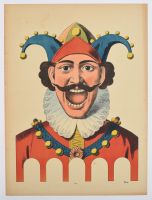 |
Halfsheet vintage print known as the
"Wissembourg Jester" or Tête de fou ("Fool's head"). It is a character in a series of popular chromolithograph prints created by the French printing company C. Burckardt of Wissembourg, France, between the late 1800s and early 1900s.
Print Details
Publisher: C. Burckardt
Location: Wissembourg, France
Medium: Chromolithography, a method of color printing
Time Period: Circa 1880s to early 1900s
Purpose: These colorful, often whimsical, prints were considered the "new media" of the era and were used for various purposes, including as decorations for carnival halls, education charts, puzzles, and puppets. They featured caricatures of political personalities, folklore heroes, and other festive characters.
Description: The print depicts a jester or carnival figure in a red tunic and a blue and red cap with bells, with a wide-open mouth, suggesting he might have been part of a mechanical display or a cutout for a "Jeu de massacre" (a type of target game) |
|
|

